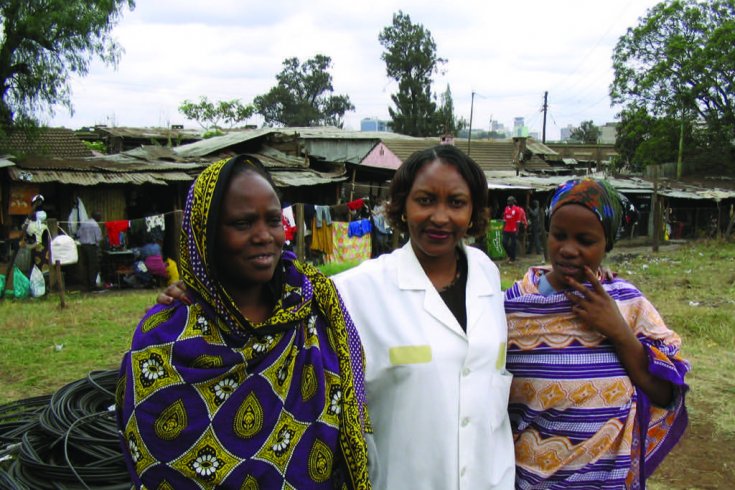
Nairobi — Jane Kamene, one of the nurses, took me into a back room and hauled out a large black book with red binding titled Death Registry. Inside, listed in neat columns, were the names, places of birth, and dates of death of 152 women, all of them sex workers who had died of aids since I was last at the Pumwani clinic almost eight years ago. But not, I noted, Hawa Chelangat. “Still alive,” said the nurse. “Still negative.”
Kawene offered to fetch Hawa from her hut and asked if I wanted to come along. Then she abruptly reconsidered. “I’m afraid we don’t have enough security to take a mzungu,” she said, meaning a white man. “You wait here.” I stepped back into the shadow of the clinic, a tiny, utilitarian building of whitewashed bricks with a corrugated steel roof, used for the past twenty years by Canadian aids researchers. For several hundred prostitutes who operate out of huts in the surrounding shantytown, the medical staff offer care in return for allowing researchers from universities in Toronto, Manitoba, and Oxford to study their hiv/aids progression rates and reactions to the disease.
By the late 1990s the aids infection rate in Kenya had ballooned to 10 percent of the population. Among prostitutes and their transient clients, it was far worse. Prostitutes alone experienced an aids infection rate of 80 percent. But the team of researchers led by Dr. Frank Plummer of Winnipeg noted something astonishing: a small group of sex workers, including Hawa, had the same exposure and faced the same risk, but remained uninfected. Plummer concluded that somehow they had to be immune. When he announced this at the 1993 International Conference on aids in Berlin, predicting that a vaccine to fight aids might well come from better understanding these women, journalists including me with a crew from the National Film Board of Canada flooded into the shantytown. Now I had come back to visit.
I knew Hawa’s hut was by the community water tap, with the village garbage heap beside it. Kamene was right: there was no safety, no law in this place. When I had made the walk before, my security had been guaranteed by Randall, hired from the chief of the shantytown. Randall looked like a handler for Evander Holyfield; despite the heat, he wore a tight, dark suit and carried an ebony cane, the sizable bulb of which he whacked purposefully into his hand while eyeballing scrambling kids and a row of surly looking men standing outside the community toilet.
From the other side of the clinic fence, the noise was deafening. A vast market auctioned off huge piles of used clothing, the kind collected in North American churches and shipped to poor neighbourhoods across the globe. I saw one boy wearing a red Harvard sweatshirt, then a teenager sporting a T-shirt bearing the logo “Jim’s Sunoco, Kitchener Ontario.” The world’s products may reach this tiny enclave, but from the clinic something far more precious is shipped out: blood samples frozen in liquid nitrogen and air-freighted to Winnipeg and Toronto where they end up under the microscopes of aids experts like Dr. Rupert Kaul, at the University of Toronto’s Faculty of Medicine.
“These women have inspired a whole field of vaccine development,” Kaul had told me in his lab at the university. Collaborating with Oxford and the University of Manitoba, Kaul has been studying hiv rates among Kenya’s sex workers for ten years. “The important thing in a vaccine,” he said, “is to find some way to avoid using hiv itself as a component.” Unlike, say, the flu vaccine, which introduces a tiny bit of virus into your system in order to alert antibodies to fight off the bigger threat, hiv in any amount is deemed impermissible. Once it is in the body, doctors can’t control the virus. But the vaccine search has been slow going. What researchers have figured out is that the resistant women, including Hawa, don’t have a regular antibody response to hiv, but a cellular one. Through a trigger that so far remains unexplained, “killer” cells in the women’s bodies are dispatched to attack infected cells.
I looked up. A familiar figure dressed in her customary purple and yellow hijab walked into the clinic compound. Hawa is a Muslim, as are a number of the hiv-resistant women. She still had a slight limp, the result of polio. I had hardly ever seen her without her five children, and one of them was with her now. Asha, whom I remembered as a girl of twelve, was now all grown up with a child of her own, making Hawa, at forty-four, a grandmother. Hawa looked feverish. Obviously she wasn’t immune to all diseases. On a trip to visit relatives up in tea country, she had contracted malaria and now needed the clinic to supply her with pills to fight it. She sat down, smiling broadly when I began to recall the weeks we’d spent working on the film. Our conversation was a struggle with her limited English and my non-existent Swahili. When necessary, Asha acted as translator. Then it was Hawa’s turn to see the nurse. I slipped her some money, not much, though I knew it would be equivalent to what she might earn in a week. She tucked the bills away and thanked me. I ought to have thanked her. Among the materials Kenya exports to the world, Hawa’s blood serum could turn out to be the most valuable of all.




